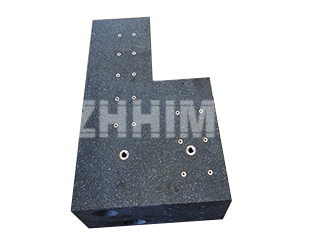In high-precision assembly and machine tool verification, the Square is the critical benchmark for confirming perpendicularity and parallelism. Both Granite Squares and Cast Iron Squares serve this vital function—acting as vertical parallel frame assemblies to check the alignment of internal machine tool components. However, beneath this shared application lies a fundamental difference in material science that dictates ultimate performance and longevity.
At ZHHIMG®, where our Precision Granite is the cornerstone of metrology, we advocate for the material that offers the most stable, repeatable, and enduring accuracy.
The Superior Stability of Granite Squares
A Granite Square is crafted from a geological marvel. Our material, rich in pyroxene and plagioclase, is characterized by its precise structure and uniform texture—the result of millions of years of natural aging. This history endows the Granite Square with properties unmatched by metal:
- Exceptional Dimensional Stability: The long-term stress relief means the granite structure is inherently stable. It will not suffer from the internal material creep that can plague metal over time, ensuring the high precision of its 90° angle remains intact indefinitely.
- High Hardness and Wear Resistance: Granite boasts high strength and hardness (often Shore 70 or higher). This resistance minimizes wear and ensures that even under heavy use in industrial or laboratory settings, the critical perpendicular measuring surfaces maintain their integrity.
- Non-Magnetic and Corrosion-Proof: Granite is non-metallic, eliminating all magnetic interference that could affect sensitive electronic gauges. Furthermore, it is completely immune to rust, requiring no oiling or protective measures against humidity, thereby simplifying maintenance and extending service life.
These physical advantages allow a Granite Square to maintain its geometric accuracy under heavy loads and varying room temperatures, making it the preferred tool for high-precision verification tasks.
The Role and Limitations of Cast Iron Squares
Cast Iron Squares (typically manufactured from HT200-250 material according to standards like GB6092-85) are robust, traditional tools widely used for perpendicularity and parallelism testing. They provide a reliable 90° measurement benchmark, and their heft is sometimes an advantage in shop environments where durability against accidental impact is prioritized.
However, the inherent nature of cast iron introduces limitations in the ultra-precision sector:
- Susceptibility to Rust: Cast iron is prone to oxidation, necessitating careful maintenance and oiling to prevent rust, which can compromise the flatness and squareness of the measuring surfaces.
- Thermal Reactivity: Like all metals, cast iron is susceptible to thermal expansion and contraction. Even small temperature gradients across the vertical face of the square can temporarily introduce angular errors, making precision verification in non-climate-controlled environments challenging.
- Lower Hardness: Compared to the superior hardness of granite, cast iron surfaces are more prone to scratching and wear over prolonged use, which can lead to a gradual loss of perpendicularity over time.
Choosing the Right Tool for the Job
While the Cast Iron Square remains a viable, robust tool for general machining and intermediate checks, the Granite Square is the definitive choice for applications where the highest possible accuracy and long-term stability are non-negotiable.
For high-precision machinery, CMM verification, and laboratory measurement work, the non-magnetic, thermally stable, and geometrically secure nature of the ZHHIMG® Precision Granite Square ensures the reference integrity needed to uphold the most stringent industry standards.
Post time: Nov-10-2025

